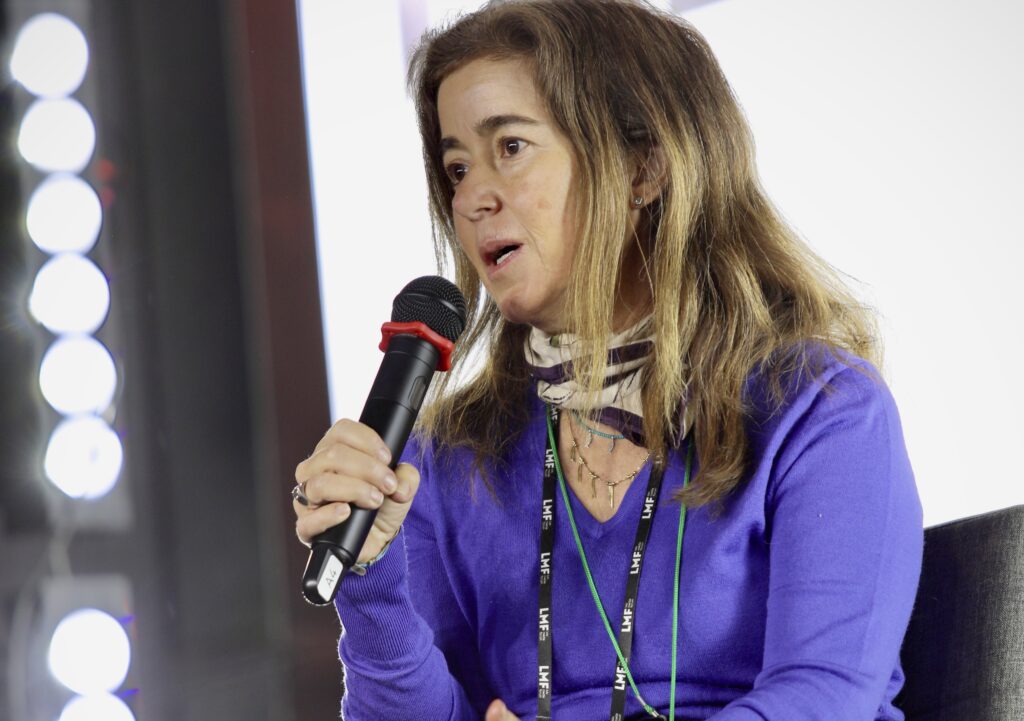
Catalina Gomez. Photo source: Lviv Media Forum
By Oleksandra Yaroshenko
The profession of an international reporter is a daily balancing act between risk, ethics, and the right to be heard. How, despite everything, can you remain true to your profession — reporting from hot spots — without losing either the power of words or your love of life? On May 16, 2025, as part of the Lviv Media Forum, journalist Catalina Gomez shared her experiences and her views on war, Iran, Ukraine, and journalism as a craft of humanity.
Catalina Gomez is a Colombian freelance journalist based in Iran. During her career, she has covered the wars in Syria, the conflicts in Gaza, the fight against ISIS, Afghanistan, and Russia’s full-scale invasion of Ukraine. Her experience is that of constant presence at the epicenters of global tragedies. In a conversation with Ukrainian journalist and editor Angelina Karyakina, she candidly admits that working in Ukraine is becoming increasingly difficult.
“When the war first started, Ukraine was in the news all the time. I was able to come for long periods, work with producers, travel to the east and west. Now everything is different. I have to fight for every penny, every day of work as a producer, and often I just work alone,” says Catalina.
In the France 24 model, for which she regularly prepares materials, the journalist shoots, edits, and conducts interviews herself. Is it difficult now to “sell” Ukrainian stories to editors abroad? The answer is yes. Previously, there was no need to do so—the events spoke for themselves. Now, you have to convince, explain, and prove that this story still matters. That it is no less important than what happened in another corner of the world yesterday. “But if you have a good story, if you find the human dimension, editors are still willing to listen,” says Catalina. Personal stories, real voices, depth — these are the things that can still “break through the wall.”
Journalism as an act of love
What is a “good story” from Ukraine? Angelina Karyakina asks Catalina Gomez. Is it a story that provides enough context? Or perhaps enough emotion? Does it always have to be something loud, from the front lines, with smoke and explosions? “No. It’s a personal story. One that, through a person’s fate, allows you to see what is really happening in the country,” Gomez replies. It doesn’t have to be from the front lines. It could be the life of a woman in Kharkiv, a teacher in Lviv, a volunteer in Kryvyi Rih. It could be children who are studying despite the unrest. The main thing is to show how war changes lives. How people try to preserve their dignity, their everyday life, their love. “And even if it seems that we have already told hundreds of such stories, there can never be too many,” she says.
When the journalist asks viewers outside Ukraine, “What would you like to hear about the war?” they often respond, “We want to see people. How they are holding on. How they live. How they fight.” And in this lies a profound truth about human perception: tragedy is exhausting. Human strength, on the other hand, inspires. “People are interested in people,” Karyakina agrees. “But if they can’t find a point of contact, they shut down. That’s why it’s not just pain that inspires, but also courage, solidarity, and the choice to live.”
How can you explain a war in two minutes?
However, there is always a challenge: context. How can you tell the story of a war, its history and its causes in a two-minute news story? “I try to include at least one or two sentences so that viewers know who started this war and why it is still going on,” says Gomez. This is no longer just a journalist’s duty, but a defense of the truth. Especially when you work for an audience that is heavily influenced by disinformation campaigns. A journalist from Colombia says that in Latin America, especially among young people, Russian propaganda has reached unprecedented levels. Her stories receive hundreds of comments, often aggressive, with personal attacks on her, her colleagues, and the entire editorial team. This wasn’t the case before. Now it has become the norm. “Even when I report on volunteer medics saving people in frontline areas, I am accused of lying,” she says. That is why context is critically important. Because every inaccuracy, every “assumption” can be used as a weapon against the truth. Not all of these comments are genuine. Some are probably written by bots. But that doesn’t change the fact that the battle for attention and trust continues every day.
Karyakina raises another important topic: the echoes of colonialism and anti-American sentiment in the region. These complicate perceptions of the war, especially when Russia uses anti-Western rhetoric. At the same time, journalists are thinking about how to find the “pain points” that will resonate. For example, a case of torture of a civilian was opened in Argentina, where society knows all too well what electric shocks, child abductions, and military juntas are. Stories of abductions, losses, and the destruction of families—things that hurt Ukrainians—can resonate in Latin American societies.
Gomez recalls the experience of Colombia, a country that has endured decades of violence, explosions, kidnappings, and wars. Colombians understand what it means to live under constant threat. Technology — drones, missiles — may be unfamiliar, but the pain of losing loved ones is familiar to everyone. This is what creates empathy. And then there is the unexpected closeness: thousands of Colombian volunteers are currently fighting in the war in Ukraine. Stories about them are heard in the most remote towns — the war is already “close by.”
From the Middle East to Ukraine
Gomez is used to working in hot spots: Iran, Syria, Gaza, Iraq. It all started in Iran, a country she believes is key to understanding the Middle East. After the 1979 Islamic Revolution, Iran became a player with a constant influence on the region, either directly or indirectly. Gomez learned Farsi, went there, and later to Syria. She worked in Aleppo, in areas where Iran had enemies. It was dangerous, but she learned how to survive and work in such conditions. The Iranian authorities knew that she was covering the Syrian opposition, but they still allowed her to work. Her experience in the Middle East prepared her for everything — except Ukraine. When she first arrived here, she admitted: “This is not my war. I know nothing about this context.” In 2014, she was in Iraq and Syria — far from the events in Crimea or Donbas. That is why the beginning was difficult. She knew how to tell people’s stories, but she did not understand the historical, political, and cultural background. However, she was lucky: in Kyiv, she accidentally met a guy who drove a car, spoke English, and had nothing to do with journalism. She asked, “Do you want to work with me?” and he agreed. Four years have passed since then, and this man has become her main fixer. Gomes admits that journalists need to know their strengths and weaknesses. Sometimes we are too confident that we “know well,” and this prevents us from seeing the nuances.
Report from Iran
Gomez is one of the few foreign journalists still working in Iran. In a country that once had offices of the BBC, CNN, and other media giants, only a few reporters remain: the French agency AFP, one Spanish media outlet, and her. Just a few voices trying to tell the story of Iran beyond the headlines about sanctions, hijabs, and the nuclear program. Gomez says, “Iran is not just politics. It’s passion, it’s beauty, it’s complexity.” She doesn’t shoot sensational reports every day — if you shoot a report that exposes the authorities, it could be your last job. That’s why Gomez is cautious. She has learned to wait for the right moment and tell stories in the second or third paragraph, not the first.
Gomez’s principle is to work in tandem with local journalists. Only together can you get the whole picture — the local perspective plus an outside view. But it’s dangerous. Many of her Iranian colleagues are behind bars. They are persecuted and tortured. Women especially. Some of the most painful stories are about girls who are imprisoned and beaten for violating hijab rules. Many of them do not dare to speak even in exile because they fear for their families who remain in Tehran, Shiraz, and Mashhad. There are other stories that are invisible to the world. For example, the life of the Afghan community in Iran – over three million people who cannot obtain citizenship but work, study, and live. Talking about them is almost taboo. But it is precisely these stories — human, painful, and quiet — that need to be heard the most.
This article was originally published on: https://ua.ejo-online.eu/ Read the original article here.
Opinions expressed on this website are those of the authors alone and do not necessarily reflect or represent the views, policies or positions of the EJO or the organisations with which they are affiliated.









































